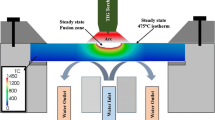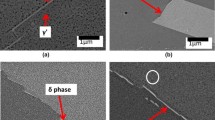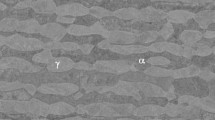Abstract
The influence of sigma phase on the hydrogen induced cracking was investigated by 3-dimensional analysis and new microstructure observation. The original point of this investigation is to introduce a new experimental technique for combined 3-D fracture analysis and metallurgical colour etching analysis, which will be a power tool for the future quantitative fractographic investigation. Since quite a low level of hydrogen is sufficient to cause the hydrogen induced cracking of ferrite phase, the hydrogen embrittlement was recognised in the as-received type 329J1 (UNS S 32900) base metal and the direct cross-sectional microstructure observation revealed that hydrogen induced cracking occurred preferentially in ferrite, while austenite showed ductile fracture. In the hydrogen-charged type 329J1 base metal containing 25% sigma phase, the sigma phase enhanced hydrogen embrittlement and the many secondary cracks associated with interaction between sigma phase and hydrogen were observed. The elevation of these secondary cracking sites on the fracture surface became drastically lower than the surrounding area because of the preferential hydrogen induced cracking sites. On the basis of the colour cross-sectional microstructure analysis, it was found that sigma phase itself and sigma/ferrite phase boundaries were preferential hydrogen induced cracking sites, while ferrite quasi-cleavage crack assisted hydrogen induced cracking in the type 329J1 base metal. In the case of as-welded 329J4L (DP3) (UNS S 31260) duplex stainless weld metal, a reduction was also recognised. When hydrogen charging was carried out for 329J4L weld metal precipitated 40% sigma phase, the strength dropped markedly compared with type 329J1 base metal containing 25% sigma phase. The strength loss was dependent on the amount of sigma phase. The fracture surface corresponded to Widmanstätten microstructure. It was cleared that sigma phase promoted strongly hydrogen induced cracking since the area of the sigma phase was always lower than other areas on the 3-dimensional fracture surface. The ferrite almost decomposed and considerable sigma phase was present. It could be concluded that sigma phase itself and sigma/Widmanstätten austenite phase boundaries were preferential hydrogen induced cracking sites in the 329J4L weld metal.
Similar content being viewed by others
References
Nilsson J.O., 1992, Overview Super duplex stainless steels, Materials Science and Technology, Volume 8: 685–699.
Nilsson J.O. and Wilson A., 1993, Influence of isothermal phase transformations on toughness and pitting corrosion of super duplex stainless steel SAF2507, Materials Science and Technology, Volume 9, July: 545–554.
Kasper J.S. and Waterstrat R.M., 1956, Ordering of Atoms in the σ Phase, Acta Cryst., 9: 289–295.
Dickins G.J., Douglas Audrey M.B. and Taylor W.H., 1956, The Crystal Structure of the Co-Cr σ Phase, Acta Cryst., 9: 297–303.
Nilsson J.O., Kangas P., Karlsson T., and Wilson A., 2000, Mechanical Properties, Microstructural Stability and Kinetics of σ-Phase Formation in 29 Cr — 6 Ni — 2 Mo — 0.38 N Superduplex Stainless Steel, Materials Science and Technology, Volume 31A: 35–45.
Walker R.A., 1988, Duplex and high alloy stainless steels-corrosion resistance and weldability, Materials Science and Technology, January, Volume 4: 78–84.
Kuroda T., Nakade K. and Ikeuchi K., 2000, Precipitation Behavior of Sigma Phase in Duplex Stainless Steels and Weld Metals, Welding in the World, 44: 17–22.
Kotecki D.J., 1989, Heat Treatment of Duplex Stainless Steel Weld Metals, Welding Journal, November, 431s-441s.
Kuroda T., Kikuchi Y., 1997, Proceeding of International. Conference., Joining of Materials (JOM8), Sigma Phase Embrittlement of Duplex Stainless Steel Weld Metal, Helsingor, Denmark: 376–381.
W. Zheng and D. Hardie, 1991, Effect of Structural Orientation on the Susceptibility of Commercial Duplex Stainless Steels to Hydrogen Embrittlement, Corrosion, Volume 47, No. 10: 792–799.
Elshawesh F., Elahresh N., Elhoud A., 1988, Effect of σ phase on pitting corrosion of 22–5 duplex stainless steel, British Corrosion Journal, Volume 33, No. 4: 285–287.
D.J. Kotecki, 1986, Ferrite control in duplex stainless steel weld metal, Welding Journal. 10: 273s–278ss.
Kuroda T. and Lundin C.D., 1994, May, Journal of The Society of Material Science Japan, Volume 43, No. 488: 562–566.
Kuroda T., Ikeuchi K., Inoue K., Nakade K. and Kitagawa Y., 2001, Three-dimensional Reconstruction of Fracture Surface Using Area Matching Algorithm, Transactions of JWRI, Volume 30, No 1: 47–52.
Kuroda T., Ikeuchi K., Nakade K., Inoue K., Kitagawa Y., 2002, Three-dimensional Reconstruction of cleavage fracture surface for duplex stainless steel, Vacuum 65, 541–546.
Author information
Authors and Affiliations
Rights and permissions
About this article
Cite this article
Nakade, K. Sigma Phase Precipitation and its Influence on Hydrogen Induced Cracking of Duplex Stainless Steel Base Metal and Weld Metal. Weld World 47, 9–20 (2003). https://doi.org/10.1007/BF03266396
Published:
Issue Date:
DOI: https://doi.org/10.1007/BF03266396




